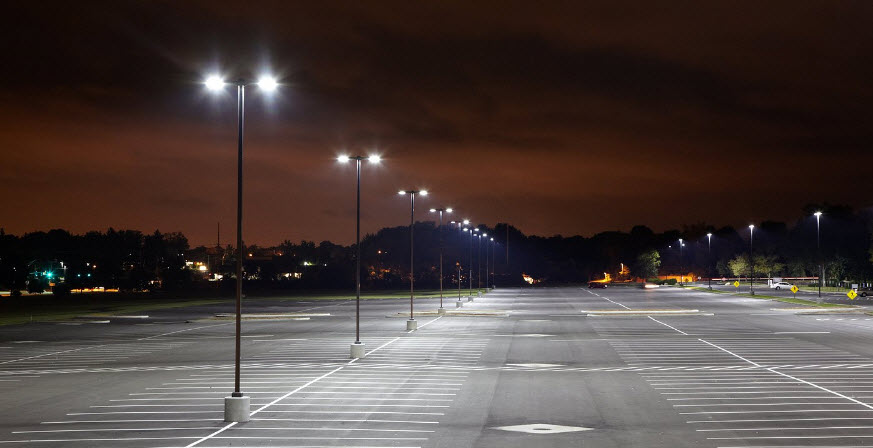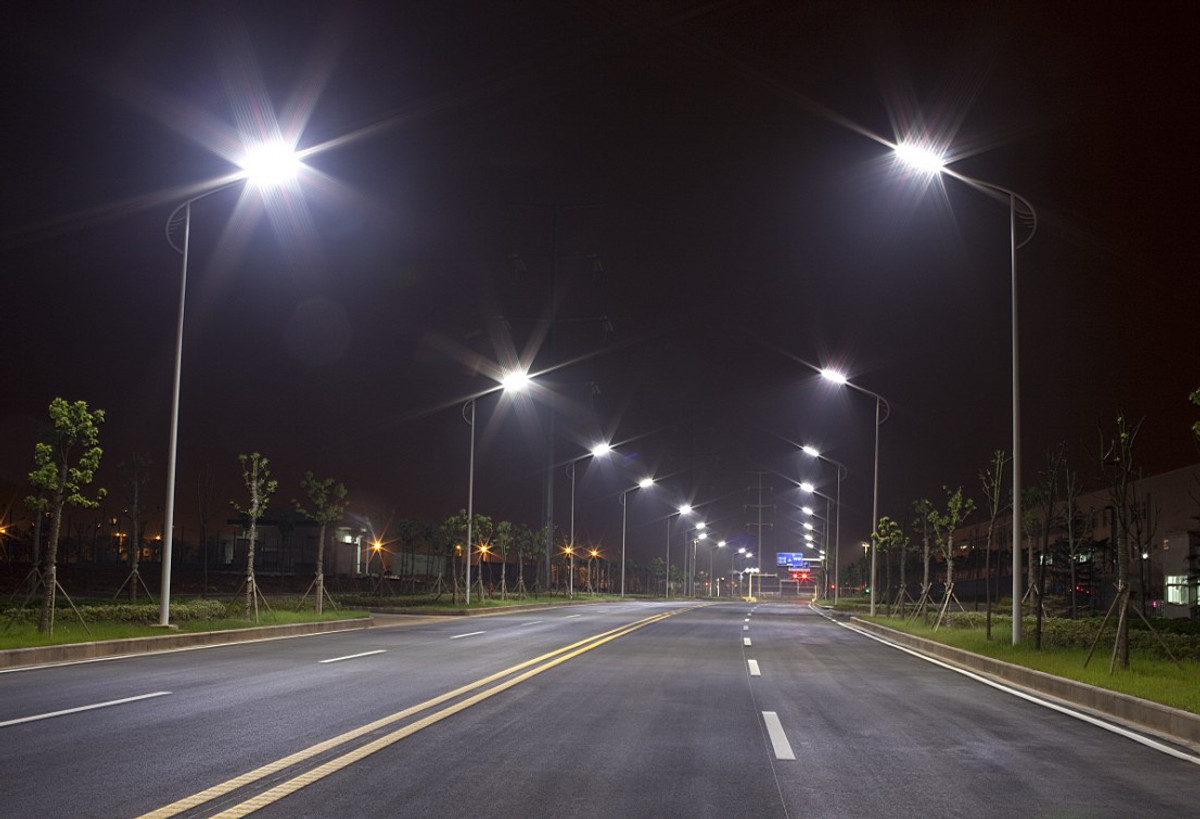Illuminating roadways and parking lots can be challenging. You’ll need to do a lot of planning before any of the associated components are purchased. Among these components will be the light poles on which you’ll be mounting the light fixtures.
Light poles are needed to mount the luminaires for any lighting project that involves illuminating large outdoor areas. They come in a variety of shapes, sizes, materials, and installation types. But one critical factor that needs to be considered is how far apart they’ll need to be spaced in your application. This will depend on many factors.
The goal of these projects will be to have bright enough light that will be suitable for the application and meet lighting requirements. The light needs to be uniform across the area so that there aren’t sections that are dimmer or brighter (or more concentrated) than others across the same space. This article is intended to help you to achieve that goal.
Understanding the different types of lighting patterns
Before you select the light fixtures to mount on your poles, you’ll want to know what type of light pattern they have. The type of light pattern that you’ll need will be specific to the application. Six general pattern types are classified by the National Electrical Manufacturers Association (NEMA) as illustrated below.

NEMA Pattern Types
Type I
- Pattern type: two-way 15° lateral distribution
- Applications: sidewalks, paths, walkways
- Fixture placement: center
- Ideal mounting height: equal to walkway width
Type II
- Pattern type: 25° lateral distribution
- Applications: wide walkways, ramps, narrow roadways, and entrance roadways
- Fixture placement: at or close to the side
- Ideal mounting height: The width of the road should not surpass 1.75 times the mounting height.
Type III
- Pattern type: 40° lateral distribution
- Applications: conventional roadways, parking areas
- Fixture placement: at the side
- Ideal mounting height: The width of the road should not surpass 2.75 times the mounting height.
Type IV
- Pattern type: 60° semicircular distribution
- Applications: wide roadways, sides of walls or buildings
- Fixture placement: at the side
- Ideal mounting height: The width of the road should not surpass 3.7 times the mounting height.
Type V
- Pattern type: 360° circular distribution
- Applications: roadways, center parkway islands, intersections, large parking areas
- Fixture placement: at or near the center
- Equal light distribution at all angles
Type VS (like Type V but with a different pattern shape)
- Pattern type: 360° square distribution
- Applications: roadways, center parkway islands, intersections, large parking areas
- Fixture placement: at or near the center
- Equal light distribution at all angles , used where the light pattern has a more defined edge.
Light Pole Spacing for Street Lighting

The types of light poles that you’ll use for street lighting (and the way they will be spaced) will depend on the nature of the street. For example, you won’t be using the same type of pole or spacing for a residential street that you’ll be using on a busy highway. A residential street will be much shorter and narrower than a highway, therefore it will not require as much light (or as many poles).
The height and spacing of street light poles will vary depending on the application. Typical heights are between 30 and 50 feet. In general, residential street light poles will have a shorter height and closer spacing when compared to those used on a wider city street or highway.
The types of luminaires that are used will be different also. Taller poles require more powerful (higher output) light fixtures.
Street Light Pole Spacing Guidelines
- Taller poles can be placed further apart from each other because the light spread from the fixture will be wider.
- The width of the street will also determine how the light poles will be spaced. Narrow streets will not require the same amount of lighting as wide streets.
- If the distance between the poles is too far, there will be dark spots between the poles. If the distance between the poles is too close, there will be bright spots between the poles. In both cases, the lighting will be uneven and not uniform across the roadway.
- As a rule of thumb, the spacing between the light poles should be 2.5 to 3 times their height. For example, if you are using 30-foot poles for your light fixtures, a 75- to 90-foot spacing between poles is recommended.
- Another thing to consider regarding street light spacing is the arrangement of the light poles. This will be dependent on the width of the street. Here are a few general tips:
- For streets that are over 65 feet wide, you’ll want to have the poles symmetrically arranged on both sides (across from each other).
- For streets that are 51 to 65 feet wide, you’ll want to have the poles arranged and intertwined with each other (opposite or shifted) on both sides.
- For streets that are 50 feet wide or less, you’ll want to have the poles arranged on one side.
- For wider streets that have a divider in between lanes, you can place additional poles in the center with two fixtures mounted on each one to illuminate both sides.
Street Light Pole Height Guidelines
The height of a light pole used for road lighting will be dependent on several factors:
- The width of the area to be illuminated. This should be roughly equal to the height of the pole.
- The amount of light required. You’ll need enough light so that drivers can safely see the road.
- Pole height minimum should be 15 feet to prevent glare. A range of 25-50 feet is recommended. In some cases, a high mast pole of 50+ feet is required.
Light Pole Spacing for Parking Lot Lighting

Poles used to mount luminaires for parking lot lighting are usually spaced depending on the type of vehicles that will be using it. This is a major factor in parking lot lighting design. If there are trucks using the lot, the poles will need to be spaced farther apart than with cars so that the trucks have more space to maneuver.
The size of the parking lot will determine the height and spacing of the light poles. Larger parking lots will require taller poles spaced farther apart than shorter ones.
The types of luminaires that are used will be different also. Taller poles require more powerful (higher output) light fixtures. You’ll need to know the lumen output of the light fixtures to determine the light output.
Parking Lot Light Pole Spacing and Height Guidelines
For parking lot lighting spacing, taller poles can be placed further apart from each other because the light spread from the fixture will be wider.
The table below is a general reference. It’s best to consult a lighting expert for a lighting plan that will provide you with the optimal illumination of your parking lot.
| Mounting Height | Spacing | Lumens |
| 15’-20’ | 20’-30’ | 12,000-18,000 |
| 20’-25’ | 30’-40’ | 20,000-30,000 |
| 25’-35’ | 40’-50’ | 30,000-70,000 |
Starting a Commercial Lighting Project?
LightMart has the expertise needed when it comes to lighting spacing and lighting layouts for parking lots and streets.
LightMart’s Light Pole Kits illuminate parking lots and streets of all sizes. We offer the right lighting solution to satisfy designers, store owners, customers, and surrounding communities. Contact us today!
David DeWald is the E-Commerce Marketing Specialist at LightMart. He has been working in the industrial and commercial lighting industry since 2013 and is based in the greater Chicago area. David specializes in digital product management, web content writing, and product marketing. He regularly publishes lighting industry-related articles on the LightMart blog. You can visit his LinkedIn profile here.
